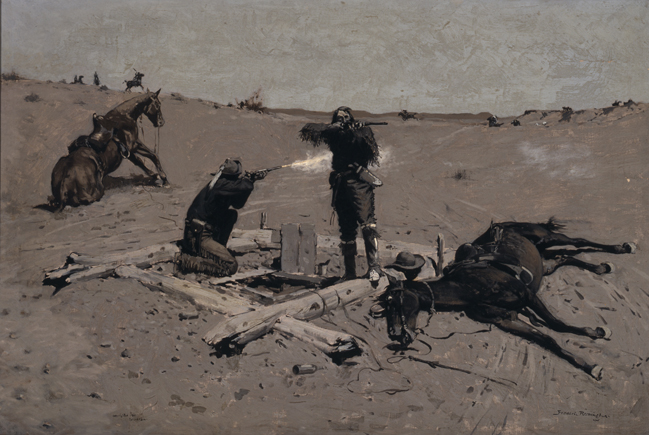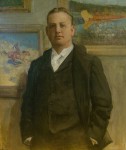
Frederic Remington
American, 1861-1909
Fight Over a Waterhole, 1897
oil on canvas
27 x 40 in.
SBMA, Gift of Barbara D. Dupee
1996.24

Remington in front of his works of art painted by Charles Chapman.
"Art is a she-devil of a mistress, and if at times in earlier days she would not even stoop to my way of thinking, I have persevered and will so continue." - Frederic Remington
RESEARCH PAPER
THE ARTIST
Frederic Remington, one of the greatest artists of the west, was born in Canton, New York in 1861. His father, Seth Remington, became a distinguished Civil War Calvary officer. Frederic idolized him and perhaps his interest in horses arose from that, as well as learning equestrian skills at a military academy. While at the academy he also discovered an aptitude for sketching, especially soldiers and battle scenes. His mother, Clara, believed in feeding Frederic large amounts of food to cure all ills, and as a result he eventually carried 300 pounds on a 5 foot 8 inch frame.
Remington did not have much of a formal art education. He studied for one year at Yale’s newly established art school. But when his father died in 1880 Frederic did not return to school. In 1881 he headed west for a summer vacation. His art career began when he sent a sketch to Harper’s Weekly Magazine from Montana. It was published in February 1882 even though it had to be redrawn by a staff artist. He returned to the East, briefly, before going back with the remainder of his inheritance. His investments in a sheep ranch and a saloon both failed. He married Eve Caton after initially being rejected by her father. Back in New York again he posed as a cowboy to sell several sketches to Harper’s and studied three months at the Art Students League, which was his last formal training. Harper’s then hired him as a correspondent and sent him to cover the Apache War and the search for Geronimo.
He was an established illustrator by 1886. He drew the illustrations for the works of Theodore Roosevelt, Owen Wister and many other popular authors. In addition, he was exhibiting his work at the National Academy of Design and won a medal in 1889 at the Paris Exposition for Native American realism. By 1890 he had his first one-man show. By that time he was concerned that the western era had passed and it was time to move on to other outdoor and military subjects. Harper’s, however, wanted only western images and his public had made him arbiter of what was truly western.
Remington’s viewed the West as a state of mind as well as place. It was a place of noble violence, red vs. white, frontier conflict and defense of white man’s values against all the odds. Thus, one of his favorite themes was the Last Stand, implying a sense of doom. It also was a role reversal with the Indian being the invader and the white the native.
In 1895 he shifted his focus to sculpting in bronze. One reason Remington did this was for his work to have a permanence that canvas could not match. He became a war correspondent again in1897 in Cuba and painted a heroic portrait of his friend Theodore Roosevelt leading the charge up San Juan Hill.
The 1900’s brought a new phase to his painting. Collier’s Weekly was reproducing his canvas’ rather than specific illustrations and the effects of impressionism can be seen in his later works with looser brushwork and shimmering horizons. The art critic for the New York Herald Tribune declared, “The mark of the illustrator disappeared and that of the painter took its place.”
He died suddenly in 1909 of appendicitis at age 48. Theodore Roosevelt proclaimed, “The soldier, the cowboy, the rancher, the Indian, the horses and cattle of the plains will live in his pictures and bronzes, I verily believe for all time.”
THE PAINTING
Like most Remington’s, there is action and violence. There is a sensation of a stopped moment, freezing the action. The fight over a water hole of course is unequal with the outcome not in doubt. Their horses are dead or dying, so there is no escape. The frontiersmen, in darker shades to stand out, are aiming in different directions giving the impression of being surrounded, as well as being vastly outnumbered. It appears, from their positions that all is lost and they are just trying to kill as many Indians as they can. Many of the Indians are set against the sky, making them stand out. There is no background of vegetation or mountains to distract the viewer from the action at hand.
The painting is done in the technique of grisaille, by which the image is executed entirely in shades of gray. In addition, the painting was done with a nocturne quality, something that Remington liked. Even though it was not evening or night, there is still an absence of light.
CONCLUSION
According to Samuels, Remington was in the fourth group of artists to go west, following artists who painted Indians, western landscapes and Indian genre. His group was the storytellers, chronicling the Indian fighting army, the Indians, the frontiersmen and the cowboys. Remington’s contemporaries were Charles Russell, Joseph Sharp and Charles Schregvogel. Of them, he was referred to as “the greatest of them all.” His early death did not allow him to go beyond this.
Prepared for the Santa Barbara Museum of Art Docent Council By Richard Strauss, February 26, 2004
BIBLIOGRAHY
Jennings, Kate F. – Remington & Russell and the Art of the American West. New York: SMITHMARK, 1993
Rush, N. Orivin – The Diversions of a Westerner. Amarillo, Texas:
The South Pass Press, 1979
Samuels, Peggy. Techniques of the Artists of the American West
Secaucus, New Jersey: The Wellfleet Press, 1990
Vorpahl, Ben Merchant. My Dear Wister – The Frederic Remington –
Owen Wister Letters. Polo Alto, CA: American West Publication
Company - 1972

Photograph of the artist, courtesy Frederic Remington Art Museum, Ogdensburg, New York
SBMA CURATORIAL LABELS
Remington painted hundreds of scenes of the rustic west from his studio in New Rochelle, New York. During a trip to the West at age nineteen, Remington decided to devote himself to the preservation of the vanishing frontier and its colorful inhabitants, publishing his images in popular magazines such as Harper’s Weekly and Collier’s. Made around the time Remington traveled to Cuba as a war correspondent during the Spanish-American War, this monochromatic painting, called a grisaille, was intended to better accommodate the image’s transference to the print medium. It depicts two frontiersmen making a last stand to protect a much-coveted source of water in the desert. The square formation of the logs surrounding the small waterhole they seek to protect suggests the indefensibility of their position and the futility of their resistance as attackers circulate easily along the high horizon.
- SBMA Gallery Label, 2012
